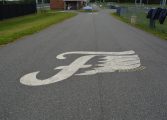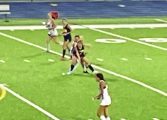By Page H. Gifford
Correspondent
Because of COVID, the Fluvanna Art Association has not met for workshops for two years. That changed when members held their first fully attended workshop with watercolor artist Bill Snow on Friday, Feb. 18.
While many members who attended were cautious and masked, they were grateful to be back and learning art techniques. Snow worked his magic with watercolor, a challenging medium to most, as members circled the table observing artistry in the making.
“Watercolors are challenging but rewarding,” he said. “I have painted in other mediums, but this is one I enjoy.”
Snow was demonstrating watercolor skies. Methodical in his approach, Snow said he is a deliberate painter as he showed some examples of skies in his work, using various techniques, including wet on wet.
A former graphics designer, Snow began painting in his spare time and took it up full-time when he retired. He has shown his representational work in galleries across Virginia. A member of FAA, Snow is a master of applying what he has learned and sharing it with others.
“Skies are a major portion of any landscape,” he said. “It takes me about 15-20 minutes to paint one. Some artists paint nothing but skies.” Snow usually uses rough 300lb watercolor paper but said supplies have gotten more expensive. A 22-inch by 30-inch sheet of cold press 300lb watercolor paper can cost upwards of $30.
For his demonstration, he used the smoother hot press 140lb, which is less expensive. Paper was of interest to members since watercolor papers are hot press, cold press, and rough. Snow, like many artists, use Arches for their paintings. It has been around since 1492 and is ideal for its absorbency and durability. A member mentioned there is now a 200lb paper and Snow added there is also a 400lb paper. The latter can also be used with acrylics.
“Watercolor board will not buckle,” he said. Buckling is a concern when painting with water on smoother surfaces. Card stock and Bristol board will not buckle if the water is controlled properly.
“Look at the paper and the pigment, how is it performing. Use your judgment.”
Watercolor paints, particularly on the high end, like Windsor Newton, are expensive but Snow encouraged artists not to be tentative when using watercolor paint. Even a small amount can go a long way.
“Watercolor dries quickly,” he said as he showed various blends of paints with different effects from bright blue skies to a foggy coastline in Maine. “I use three colors in painting skies.” Like most watercolor artists, Snow works light to dark whereas in other mediums it is the opposite. Color mixing is not what the novice thinks it is. All skies are not blue. It is varied and Snow used colors like blue and burnt umber. “Be careful when adding too many colors you could get mud.”
“I have used a little bit of white paint for highlights but prefer to preserve the white paper.” Many traditional watercolor artists prefer to use the white of the paper rather than use white paint for highlighted areas. “I will also mask in an area and uncover it later to preserve the white. White areas always lead to a question regarding erasing.
“Use an X-Acto knife or razor blade to scrape away pigment to expose white areas.” It is wise to be careful when doing this on hot press 140lb smooth paper since it is less durable than 300lb cold press, which can take more abuse.
Brushes are an essential tool and Snow uses upscale paintbrushes with bristles made from squirrel hair and beaver hair. He has had some paintbrushes for years.
“These brushes will hold water better than synthetic,” he said as he made light sweeping motions with his brush and softly blended other areas. “Keep it moving.”
He used a hairdryer to speed up the process but usually lets it dry naturally. “I would suggest you go for it.”
Regarding his comment, Windy Payne said to a fellow member, “You have to be brave.”
“I like to create spontaneity in my skies,” he said as he kept working on blending the colors.
Though Snow uses costly tools, paint, and paper in his work, professionals know these things work to create phenomenal paintings and less frustration in the outcome. But in his wisdom, Snow knows the best thing any artist can do is practice their techniques. In his parting words, “Get a pad of inexpensive watercolor paper and just practice making skies.”




